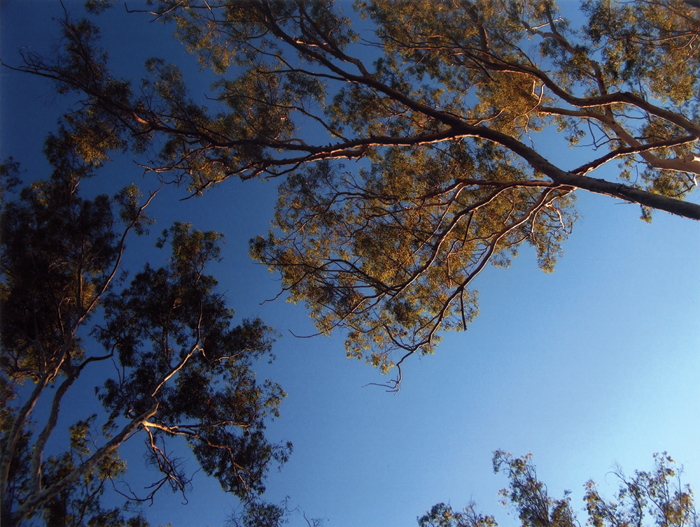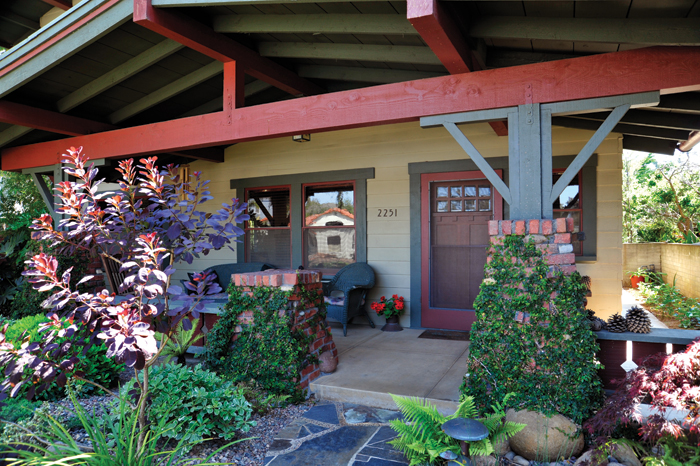|
Your home's landscape
By Alexander D. Bevil
Among the first and relatively simple undertakings a property owner can do to save energy costs is to find and reverse areas of involuntary energy transference, known as Passive Measures.
Did you know that an inspection of a historic building's landscape may reveal Passive Measures or that the restoration of missing historic landscape features and/or the rehabilitation of a historic setting may improve a historic building's energy efficiency?
The character of the physical environment in which a building was situated, its historic setting, is its spatial relationship to its surroundings during the building's period of historic significance. A historic setting normally includes nearby introduced or native landscape features, such as foundation plantings, shrubs, trees, flower and vegetable gardens. The historic setting could also include similar landscape features within a historic district, or open natural open space or semi-natural landscaped parkland.

Historic eucalyptus trees grace the south lawn of the Marston House forming a canopy high over head. These are examples of historic plantings that, while not native trees, should not be removed from a landscape.
Native and historic should not be confused, but sometimes are. Native plants are those that have occurred in a particular area before the influence of human settlement. Exotic plants are those introduced to an area through human action. In every region of the earth, humans have impacted plant life that was in place before their arrival. Both are important and tell the story of a place. Photo Sandé Lollis
Usually, landscape rehabilitation or restoration is the last phase of a historic property owner's preservation plan. However, while usually given short shrift, they are important preservation treatments. Besides increasing energy efficiency by lowering fuel and water use, landscape rehabilitation or restoration helps to beautify the property, which in turn increases its property value. A successful landscape rehabilitation or restoration may stimulate neighboring property owners to improve their landscapes, historic or not, thereby increasing surrounding property values.
The first step in a historic landscape evaluation is an inventory of existing plant material and hardscape features, and their arrangement throughout the property.
Using a generic early 20th century San Diego bungalow as an example, does the surrounding landscape still reflect its original plant pallet and layout? Or is it a mish-mash of overgrown trees and shrubs that successive owners bought on sale at Handyman and planted some thirty years ago? It may be necessary to hire a local historic landscape or garden consultant to assist in identifying historic and non-historic plant material and hardscape features.
A comprehensive landscape rehabilitation/restoration plan should include identifying historic plant materials that perform passive solar energy functions. These might include mature trees and/or shrubs, evergreen as well as deciduous, as well as pergolas, patio covers, lath houses, or other landscape features used for sun shading and wind breaks. Historic photographs and interviews with past owners or neighbors are excellent ways of learning about a property's historic landscape.
The preservation and rehabilitation of existing trees and shrubs through thinning, pruning, fertilizing, and watering, as well as the introduction of missing landscape material should be included in a historic property's landscape maintenance plan.
The planting of period-appropriate deciduous trees and shrubs, like liquidambar (American Sweetgum) or pomegranate for example, can be an effective way to cool southern and southwestern exposures during the hot months, while allowing sunlight to warm them during the cooler winter months.
Not only do mature trees and shrubs perform passive energy conservation, they lessen the effects of wind, rain, and ultraviolet rays that could accelerate a historic building's physical deterioration.
Now, don't make the mistake as some local homeowners do of ripping out mature non-California native or non-period-appropriate plant species from their gardens. How long do you think it would take for a newly planted shade tree to reach the height of the 80 to 100 year-old-original? Certainly this will not happen in your lifetime.
Likewise, don't think you have to convert your gardens into a desert landscape in order to save water. San Diego's Mediterranean climate can support such drought-tolerant species as acacia, eucalyptus, strawberry tree, fremontia, pine, bottlebrush, manzanita, and rosemary.
By now, some of you are probably wondering, "What do I do with my small patch of lawn in front or in the backyard of my 1958-built California Modern Ranch style house in Clairemont?"
There are several appropriate restoration alternatives that can be done. First, remove the existing lawn, which probably is a mixture of grass and forbs by now, and about 6-8" of soil. Be sure to recycle it instead of dumping it into a landfill. Then, apply organic fertilizer and amendments, such as blood and bone meal, gypsum and iron chelate, with imported topsoil. Now is the best time to install a water-efficient irrigation system with a programmable electric valve timer system. A renovated lawn bed will facilitate deep watering, at lesser intervals, which, in turn, will facilitate deeper grass roots, and better drought-tolerance.
Several excellent water-thrifty turf species are available from seed, plugs, or sod, including Hybrid Bermuda, Buffalo, Blue Grama, Seashore Paspalum, or Zoyzia grass. However, most are warm-season grasses that brown out during winter. They can also be very aggressive and overrun adjacent garden beds.

This expansive northeast facing porch offers shade and cover to cool the house. A stone path to the door meanders through a rock garden interspersed with drought-tolerant plants. As an interpretive landscape it still retains the spirit of the historic home. Photo by Sandé Lollis
Fortunately, lawn alternatives, such as a groundcover of low-growing thyme, chamomile, Scotch moss, Japanese spurge, or hierba dulce can be used. Most will tolerate light foot traffic, but the use of natural stepping stones, brick or concrete footpaths can prevent unwanted paths.
Not only do these lawn alternatives require less water, they are less labor intensive to maintain, and often require fewer applications of fertilizers and dangerous chemicals to keep them weed or pest-free. Indeed, a lawn substitute will reduce a building's carbon footprint by eliminating the need for a gas or electric-powered mower. However, a set of shrub-shears can be used for cutting off spring flowers to reduce swarming bees.
Other water conservation techniques include grouping plants with similar water needs so that plants that require little irrigation aren't mixed with those that do. Apply several inches of organic or non-organic mulch, such as ground-up tree bark, straw, gravel, river rock, or small pebbles to plantings. Stone mulch should not include non-period-appropriate colored gravel. Consider replacing a rear lawn with period-appropriate landscape improvements: a wooden deck; shade trellis; brick patio, gravel play area; built-in barbecue, etc. Install soaker hoses or a drip-irrigation system. Mulch can be used to hide them from view for more authentic-looking gardens.
The application of Active Measures stated above to preserve, rehabilitate, and restore the historic setting associated with a historic property's landscape, will result in Passive Measures that will increase a historic property's energy and water efficiency, while lowering its carbon footprint, all without impacting its historic character. Besides saving money through the reduction of energy and water use, these measures will increase its aesthetic value, and hopefully stimulate like activities in the surrounding neighborhood.
More information on Active and Passive landscape techniques
The Mediterranean Garden: The Journal of the Mediterranean Garden Society.
mediterraneangardensociety.org
Smith, Baird M., AIA. Conserving Energy in Historic Buildings. National Park Service Preservation Brief No. 3.
https://www.nps.gov/history/hps/TPS/briefs/brief03.htm, April 1978.
Sunset Western Garden Book. Menlo Park: Sunset Publishing Corporation, 2008.
"Walk-on Lawn Substitutes." In Sunset: Living in the West. Sunset Magazine
sunset.com/sunset/garden/article/0,20633,699454,00.html
2004-2008.
Excellent examples of low-water demonstration gardens can be found at the following locations:
The east side of the San Diego County Administration Building,1600 Pacific Highway, San Diego
The Gardens of Ridgehaven: City of San Diego Environmental Services Greenbuilding, 9601 Ridgehaven Court, San Diego
The Water Conservation Garden: Cuyamaca College,
12122 Cuyamaca College Drive W., El Cajon
Historic Garden Research on the web:
oldhousegardens.com
cr.nps.gov - A guide to National Park Service resources of cultural landscapes
ahlp.org - The Alliance for Historic Landscape Preservation
siris.si.edu - Smithsonian site containing the Archives of American Garden
|
|
MORE FROM THIS ISSUE
From the Editor
2009 People In Preservation Award Winners
Historic Preservation & Environmental Conservation
The Green Game
Making your historic home more energy efficient
Your home's landscape is green in more ways than one
San Diego Trust & Savings Bank Building
Black Gold in San Diego
2009 Most Endangered List of Historic Resources
Tragedy Unfolds
Preservation Community
Reflections
Recognition
The Whaley House Porch Returns
Museum News: Marston House
Borrego Springs Modern lll
Borrego's future lies in its past
Adobe University
An Enchanted Evening at PIP
Looking for historic homes, gardens or commercial sites
Help Us
Lost San Diego
Strength in Numbers
Advertisements
DOWNLOAD full magazine as pdf (9.7mb)
|





